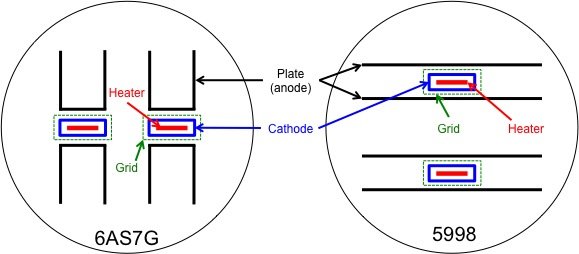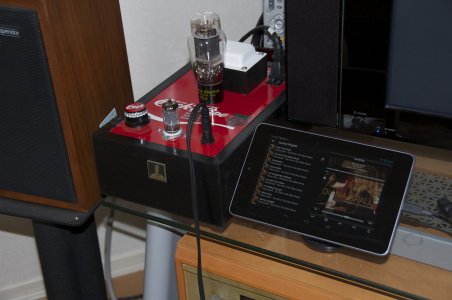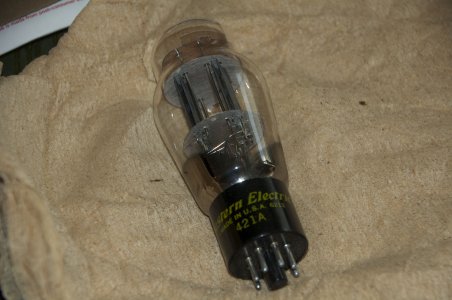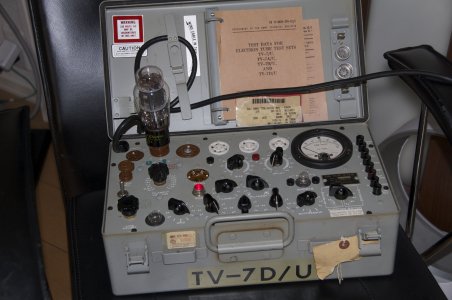Yeah, you can read up about interpreting load lines. The lowest distortion for a triode will be a load line of infinite impedance (C4S), while acceptable performance generally starts at around 3x plate impedance. You can also look at the load line you've drawn and examine each chunk of the load line that has been sliced up by the curves on the graph. If the segments are pretty equal in length, especially close to your quiescent operating point, then you'll probably be OK. If the segments get really short on one end and really long on the other, you will hear that.
You are using an out of date browser. It may not display this or other websites correctly.
You should upgrade or use an alternative browser.
You should upgrade or use an alternative browser.
Tube Rolling w/Crack
- Thread starter Dr. Toobz
- Start date
xcoolhandx
New member
6GU7 is a NO-GO,someone mention running "6GU7"on crack along with E80CC...all em I getting is some "hum"..waist of time
L
Loon
Guest
Pin assignment is different
xcoolhandx
New member
thanks,hope this helpsLoon said:Pin assignment is different
http://www.ebay.com/itm/201083377532
L
Loon
Guest
Looks promising. Keep us updated.
rlyach
New member
I just received my Tung Sol / Chatham 5998 and couldn't believe the difference from either the RCA or Svetlana 6AS7G. I then looked closely at the cage structure of each tube and noted a very significant difference. In the 5998 the plate is much longer than the cathode and grid, which will collect electrons that are even emitted on the sides of the cathode. Further, the 5998 topology will also shield one triode from the other, reducing cross talk. The 6AS7Gs I had have the cathode and grid about the same length as the plate. I assume this was to facilitate uniform electron travel, but this also allows some (probably small but also probably not insignificant) cross talk between the triodes. Is this correct? I guess I was struck at the significant difference between the tubes. I have drawn a representation of the two tubes for reference. I hope I got it right. Anyway, this difference may help explain why the 5998 sounds so much better than the RCA 6AS7G configuration.
Attachments
You could play a strong 60Hz tone into the left channel of your Crack and measure the 60Hz output on the right channel with the 6080 and 6AS7 to get a feel for whether or not there is any crosstalk difference between the two.
FWIW, the spacing is pretty tight between all the elements in one half of a 6080 compared to the distance between the two structures themselves.
FWIW, the spacing is pretty tight between all the elements in one half of a 6080 compared to the distance between the two structures themselves.
rlyach
New member
PB,
I used audacity to create a 60 hz tone on the right channel and played it through my DAC which has the capability to reach +4dbu (pro audio 0VU). Then I sent it to the amp and listened with a pair of headphones. I definitely heard the tone on the quite channel. I then used tape to isolate the ring (right channel) on the TRS plug to hear just the cross talk. The signal was quite a bit louder with the RCA 6AS7G than the 5998, although it was still present with the 5998. I am not sure where the cross talk is coming from but in order to hear it you have to have the amp up at 80% volume with with a +4dbu signal. At -10dbV I can't hear anything with either tube. That is where the amp is spec'ed to run. Now I will look for an oscilloscope to actually do some more measurements. One more thing, I noticed that the 5998 was stronger then the 6AS7G that I have. All in all I like my current combination of the 1958 French RT 12AU7 long plate (balanced) and the 5998. I am really enjoying this amp.
P.S. You are correct on the spacing. The plate separation on the 6AS7G is about 2.5mm for each triode, and about 6mm between the triodes.
I used audacity to create a 60 hz tone on the right channel and played it through my DAC which has the capability to reach +4dbu (pro audio 0VU). Then I sent it to the amp and listened with a pair of headphones. I definitely heard the tone on the quite channel. I then used tape to isolate the ring (right channel) on the TRS plug to hear just the cross talk. The signal was quite a bit louder with the RCA 6AS7G than the 5998, although it was still present with the 5998. I am not sure where the cross talk is coming from but in order to hear it you have to have the amp up at 80% volume with with a +4dbu signal. At -10dbV I can't hear anything with either tube. That is where the amp is spec'ed to run. Now I will look for an oscilloscope to actually do some more measurements. One more thing, I noticed that the 5998 was stronger then the 6AS7G that I have. All in all I like my current combination of the 1958 French RT 12AU7 long plate (balanced) and the 5998. I am really enjoying this amp.
P.S. You are correct on the spacing. The plate separation on the 6AS7G is about 2.5mm for each triode, and about 6mm between the triodes.
You should be able to get an AC voltage reading with your meter for the channel that's supposed to have the 60Hz and the channel that isn't. This should give you a good starting point for actually measuring the crosstalk.
Using the scope will let you use something like a 1Khz tone, which will be quite distinct from 60Hz noise introduced through the mains. (IE better accuracy)
Using the scope will let you use something like a 1Khz tone, which will be quite distinct from 60Hz noise introduced through the mains. (IE better accuracy)
rlyach
New member
I don't have my multimeter here in my office so I can't do the measurements yet, but I do need to make a correction. I traced down the cross talk to the signal source and not the amp. When I generated the tone on a stereo channel I left the other channel with no data. That was a big mistake. I repeated my initial testing by generating a 60 hz tone on the right channel and silence on the left channel. Now I get no audible crosstalk with either tube even with the volume all the way up. My Tesla T1s have an SPL of 102db so it appears that if there is any crosstalk difference between the tubes because of their respective topologies, it is moot. This seems more reasonable to me.
JamieMcC
Active member
Exaliftin said:I am sensitive to sibilance on a lot of recordings and was wondering if there are any tubes that can help smooth out any harsh sounds. I have the crack speedball with modi dac. Thanks
Mullards in either one or both tubes positions would be worth a try. Both are nice sounding tube also ;D
I purchased an RCA Black plate 6AS7G (probably dated 1950/60s) and it sounded like crap imo. I'm not sure if I got a defective tube (though it was tested prior to purchasing) it sounded muddy compared with the Philips JAN 6080WC tube that came with my Crack kit. The difference was astonishing. The analytics were gone and sounded "ordinary", nothing magical about it.
The driver tube I'm using is a Telefunken 12AU7 ribbed plate. (Fantastic btw)
The driver tube I'm using is a Telefunken 12AU7 ribbed plate. (Fantastic btw)
JamieMcC
Active member
Early 1950's Tung-sol 5998 Clear top!
I am actually quiet chuffed with this find, it was in with a bunch of various different untested tubes so took a bit of a gamble with it. First try it didn't work no sound no glow on the heaters :'(
I pulled it out and had a look to see if I could see any internal damage then retried it ah ha heaters are now glowing and sound but slightly muffled and occasionally dropping out and in on one channel. ???
Pulled it out to check the pins and they were totally black with some kind of hard carbon or oxidation type of residue. Ten minutes of pin scraping with a xacto knife and a little buff with scotch brite pad later gleaming pins reinsert deep breath and a sigh of relief tubes now working perfectly and its a beautiful sounding tube what a result!


I am actually quiet chuffed with this find, it was in with a bunch of various different untested tubes so took a bit of a gamble with it. First try it didn't work no sound no glow on the heaters :'(
I pulled it out and had a look to see if I could see any internal damage then retried it ah ha heaters are now glowing and sound but slightly muffled and occasionally dropping out and in on one channel. ???
Pulled it out to check the pins and they were totally black with some kind of hard carbon or oxidation type of residue. Ten minutes of pin scraping with a xacto knife and a little buff with scotch brite pad later gleaming pins reinsert deep breath and a sigh of relief tubes now working perfectly and its a beautiful sounding tube what a result!
kscwuzhere
New member
Retrofitted my crack to run the 5687 on 2 toggle switches and all I can say is WOW! I currently have the Raytheon JRP 5687WA and it has done wonders for my set up. Before the mod, the two tubes I found myself using the most were my Telefunken e80cc and my RCA long black plate 12bh7a D getter.
The Telefunken e80cc really brings out the highs for the hd650s (removing all veil) and has a quite impressive overall soundstage. Instruments are full but blend into each other a little bit (compared to the 12bh7a and the 5687). The overall sound signature is balanced with the hd650s and the bass is tight yet lush (missing from the 5687).
The RCA black plate 12bh7a is one of my favorite tubes because of its wide soundstage and its overall lushness. The bass is lush like the e80cc but isn't quite as tight as it feels looser making it "tubier". The 12bh7a makes the beyerdynamic T1s extremely balanced but doesnt quite have the same extension in the highs that the e80cc and the 5687 has that the hd650s need.
Finally, the Raytheon military spec JRP 5687WA. This is the most 3 dimensional sounding tube I've ever heard. The hd650s sound incredibly large and as a result instrument separation has become pretty incredible too. The one downside of this tube is its lack of bass presence. The hd650s are a generally bassy pair of headphones and the raytheons recess it quite noticeably. While still being incredibly tight and fast, its lack of wholebodiness (in the bass) is a little disappointing. Besides the slightly recessed bass the tube is incredibly extended and balanced and I'm going to roll my crack with some other 5687s/equivalent to hopefully bring that bass back to life.
The Telefunken e80cc really brings out the highs for the hd650s (removing all veil) and has a quite impressive overall soundstage. Instruments are full but blend into each other a little bit (compared to the 12bh7a and the 5687). The overall sound signature is balanced with the hd650s and the bass is tight yet lush (missing from the 5687).
The RCA black plate 12bh7a is one of my favorite tubes because of its wide soundstage and its overall lushness. The bass is lush like the e80cc but isn't quite as tight as it feels looser making it "tubier". The 12bh7a makes the beyerdynamic T1s extremely balanced but doesnt quite have the same extension in the highs that the e80cc and the 5687 has that the hd650s need.
Finally, the Raytheon military spec JRP 5687WA. This is the most 3 dimensional sounding tube I've ever heard. The hd650s sound incredibly large and as a result instrument separation has become pretty incredible too. The one downside of this tube is its lack of bass presence. The hd650s are a generally bassy pair of headphones and the raytheons recess it quite noticeably. While still being incredibly tight and fast, its lack of wholebodiness (in the bass) is a little disappointing. Besides the slightly recessed bass the tube is incredibly extended and balanced and I'm going to roll my crack with some other 5687s/equivalent to hopefully bring that bass back to life.
Similar threads
- Replies
- 3
- Views
- 2K




